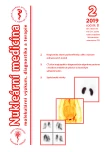Ascites detected on a whole-body bone scan
Authors:
Viera Rousková 1; Otto Lang 2
Authors‘ workplace:
Oddělení nukleární medicíny, Oblastní nemocnice Trutnov a. s., ČR
1; Oddělení nukleární medicíny, Oblastní nemocnice Příbram a. s., ČR
2
Published in:
NuklMed 2019;8:34-35
Category:
Overview
66-y-old lady suffering from an abdominal pain was admitted to our surgery department. She cooperated; she was afebrile, without dyspnea or icterus. She lost her apetite, but she did not lose her weight. She had a history of hypertension; diabetes compensated with oral antidiabetics and compensated hypothyroidism, but no cancer history. Physical examination was normal except for obesity. Chest X-ray was negative, abdominal ultrasound revealed a gallbladder stone and was highly suggestive for liver cirrhosis with an ascites. Subsequently performed gastroscopy disclosed a hiatal hernia and an ulcer on the large curvature with mucosal infiltration; nevertheless, biopsy did not prove a malignancy. Gynecological work-up including sonography was also unremarkable. Unenhanced abdominal CT confirmed a large volume of ascitic fluid (it was drained 8600 ml of sanguinolent fluid finally) and omental tumor infiltration. Laboratory investigations revealed tumor markers elevation; there were increased levels of CA 19-9 (123.4 kIU/l), CA 125 (93.2 kIU/l), HE 4 (544 pmol/l), and ROMA score (74.3 %; it serves as an estimate of epithelial ovarian cancer; it is based on CA 125 and HE 4 levels and menopause status); CEA was negative. Bone scan was performed as a part of a diagnostic work-up of a malignancy of an unknown primary. Whole-body bone scan was performed three hours post injection of 800 MBq of 99mTc-HDP using a gamma camera BrightView XCT (Philips). Diffusely increased extra osseous accumulation in the whole abdominal cavity was detected besides physiological accumulation in the axial skeleton and large joints. (Fig. 1) Patient developed and acute renal failure with a progressive electrolytes imbalance; she died within four weeks after an admission (from cardiopulmonary failure). Primary tumor was not detected, so oncological therapy was not provided; necropsy was not performed.
Keywords:
bone scan – tumorous ascites
Sources
- Soundararajan R, Naswa N, Sharma P at al. SPECT-CT for characterization of extraosseous uptake of 99mTc-methylene diphosphonate on bone scintigraphy. Diagn Interv Radiol 2013;19 : 405-410
- Lamki L, Cohen P, Driedger A. Malignant Pleural Effusion and Tc-99m MDP Accumulation. Clin Nucl Med 1982;7 : 331-333
- Cole TJ, Balseiro J, Lippman R. Technetium-99m-Methylene Diphosphonate (MDP) Uptake in a Sympathetic Effusion: An Index of Malignancy and a Review of the Literature. J NucI Med 1991;32 : 325-327
- Borzutzky CA, Spinuzza TJ, Turbiner EH. Technetium-99m MDP Accumulation in Malignant Ascites. Clin Nucl Med 1985;10 : 731-732
- Chakraborty D, Manohar K, Kamleshwaran KK et al. Tc99m-MDP uptake in ascitic fluid in a patient with prostate carcinoma: A clue to detect metastases. Indian J Nucl Med 2011;26 : 161-162
- Siegel ME, Walker Jr WJ, Campbell JL II. Accumulation of Tc-99m-diphosphonate in malignant pleural effusions: detection and verification. J Nucl Med 1975;16 : 883-885
- Shih WJ, Domstad PA. Localization of a Skeletal Imaging Agent in Nonmalignant Ascites. Clin Nucl Med 1988;13 : 137-138
Labels
Nuclear medicine Radiodiagnostics RadiotherapyArticle was published in
Nuclear Medicine

2019 Issue 2
Most read in this issue
- CT pulmonary angiography as a part of a diagnostic algorithm in a patient with a recurrent pulmonary embolism and a chronic renal failure
- Detection of an acute pyelonephritis in children – a value of imaging methods
- Ascites detected on a whole-body bone scan
- Ventilačně-perfUzní scintigrafie plic stanovisko Výboru ČSN M k provádění vyšetření
